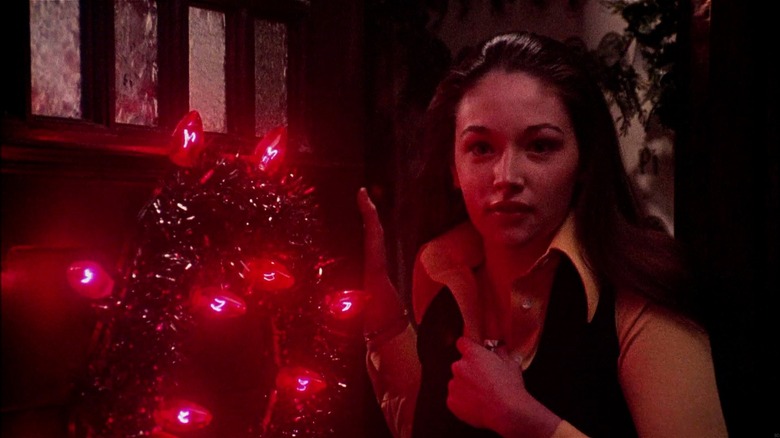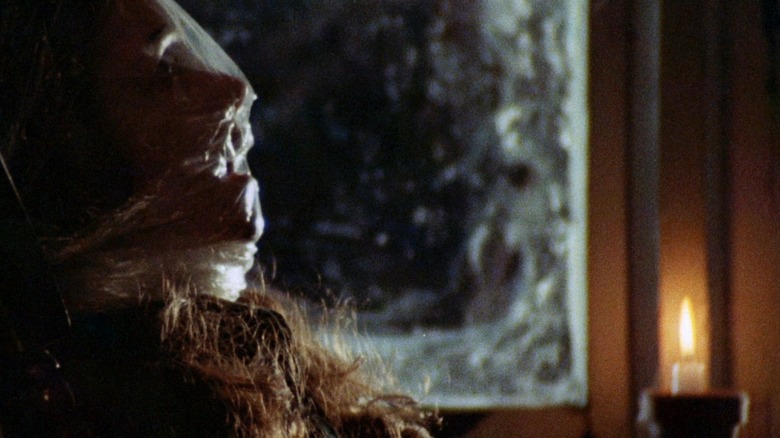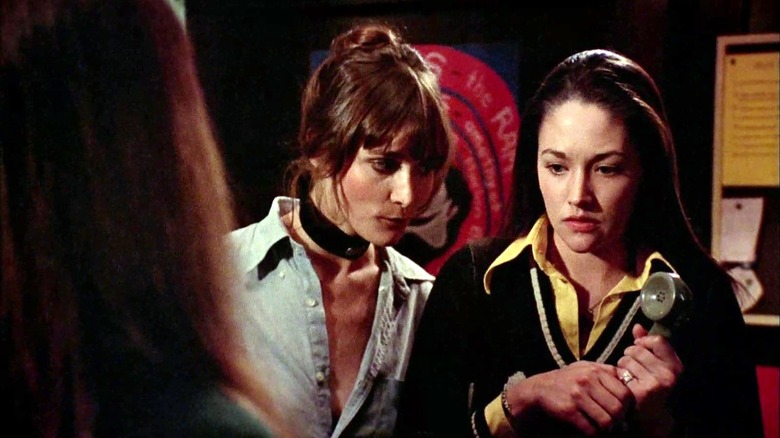The Chilling Real-Life Murders That Inspired Black Christmas
Have you heard of the urban legend "The Babysitter and the Man Upstairs?" Dating back to the 1960s, the urban legend talks about a female babysitter watching television — having put the children to bed upstairs — when she receives a call from a man asking her to check on the kids. While the babysitter ignores the man's instructions many times, the frequency of the calls unsettles her, prompting her to call the cops. Once the cops arrive, they inform her that the call was coming from inside the house all along — upstairs, to be precise, where the unidentified man had already killed the children.
This grisly myth was the basis for director Bob Clark's 1974 slasher "Black Christmas," where residents of a sorority house have to contend with repeated calls from an unknown man amid an unsettling disappearance among their group. The genre trope of a sinister killer calling from within the house has been employed in several films that use this device to amp up the scares, but "Black Christmas" manages to amplify it further with bursts of anxiety-riddled suspense and gory violence. However, Clark's film is not just a creative retelling of the urban legend alone; it is also based on a series of real-life murders that took place in the Westmount neighborhood of Montreal, Quebec.
Although the film was initially supposed to be a dramatic retelling of these murders, the script underwent numerous alterations, including a shift in setting and the incorporation of young adult characters who are part of a sorority. In the end, the combination of such a terrifying real-life event with a spooky urban legend birthed a highly disturbing slasher-thriller that inverts the traditional emotions associated with Christmas. Let us dive deeper into the murders that inspired Clark's film.
Inspired by brutal murders
According to Paul Downey and David Hastings' "It's me, Billy — Black Christmas Revisited," a 14-year-old teen named George Wester bludgeoned his mother to death with a baseball bat, which he also used to injure other family members. His siblings, Mina and Andrew, aged 8 and 12 respectively, were taken to the hospital because of their serious injuries (which they thankfully recovered from). The ferocity of this grisly incident shocked the town's residents, as a murder of this nature was unheard of in Westmount (a neighborhood that was associated with being quiet and crime-free up until this point). The murder took place on November 17, 1943.
Around the same time, the urban legend of the babysitter and the man upstairs spread rapidly and caused a citywide panic, especially due to a still-unsolved murder case of a babysitter named Janett Christman a few years later in March 1950. The details of this horrific murder are rather sparse; according to reports of the crime, the police received a distressed call from Janett but were unable to track her location due to the brief nature of the call. Once the owners of the house she was babysitting for returned, they found her body, which was grievously assaulted and rife with defensive wounds from an intense struggle. Janett was only 13 years old at the time of her tragic death, and the three-year-old baby she was looking after was unharmed.
Screenwriters Roy Moore and Timothy Bond used aspects of these murders to write the script for "Black Christmas," which was tentatively titled "Stop Me!" at the time. The Lipstick Killer was also apprehended in 1946, and Moore/Bond took inspiration from the killer's modus operandi of leaving chilling messages with lipstick on mirrors to frame some scenes in their evolving script.
Black Christmas reinvented the slasher genre
The unknown killer in "Black Christmas" is dubbed Billy, although this name is never referenced directly throughout the film. The real-life crimes that inspired the script helped craft Billy as a terrifying figure — one whose silhouette and voice are enough to induce fear, especially when he kills his targets in sudden bursts of violence. The telephone is used to introduce amplified scares into the story; the sound of the phone ringing acts like a precursor to a horrific crime and the advent of something ominous in a house that is constantly being watched by a dangerous stranger.
As the script was streamlined over the years, Bond and Moore parted ways due to funding issues and other internal conflicts, until it reached Bob Clark, who introduced critical changes to the story to make it more effective. The graphic aspects were dialed down, characters were fleshed out to inject some humanity into a tale that was bleak from start to finish, and the killer's presence became more subtle, making Billy more terrifying in the process. Moreover, as the audience also has no idea who the killer is until the end, this allowed Clark to present various characters in the film as potential suspects, adding more stakes to the interpersonal dynamics between them.
Another aspect that makes "Black Christmas" so chilling is the inclusion of the killer's POV shots, which were framed in a brutal, uncompromising manner to illustrate Billy's unpredictable nature. This was rarely done before to such an effect at the time, making Billy the killer a dangerous phantom free to move around the sorority house, taking down one victim at a time. Almost 50 years later, Clark's slasher film has lost none of its ability to unnerve.


